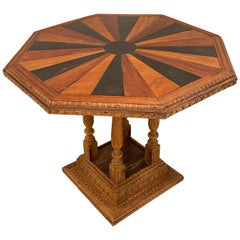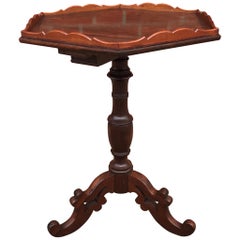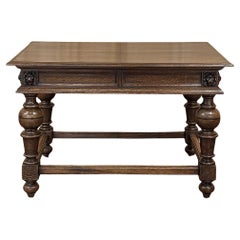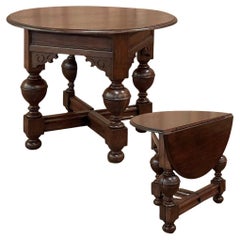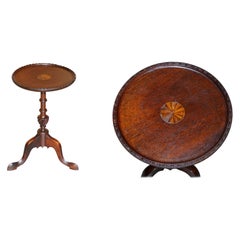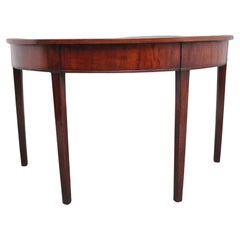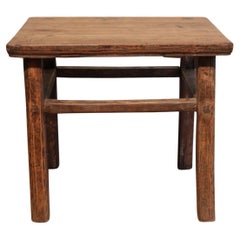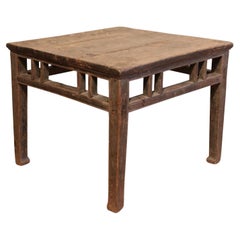Dutch Colonial End Tables
to
Height
to
Width
to
Depth
to
3
1
4
2,291
1,032
387
184
158
150
139
138
127
120
108
53
34
27
24
10
10
9
4
4
2
2
1
1
3
2
1
1
1
4
4
4
Style: Dutch Colonial
19th Century Dutch Ceylonese Specimen Table
Located in Southampton, NY
19th century Dutch Ceylonese specimen table, circa 1890. Handmade in the Dutch style with a Ceylonese twist on the base in Sri Lanka. Various woods include: Nadoun, satinwood, mahoga...
Category
Late 19th Century Sri Lankan Antique Dutch Colonial End Tables
Materials
Ebony, Mahogany, Satinwood
Amazing & Stylish Wine Table or End Table with Hexagonal Top on Tripod Base
Located in Lisse, NL
Fine quality, geometrical design, late 19th century table.
This beautiful quality hardwood table of colonial origin comes with a stunning grain in the solid wooden table top. This m...
Category
Late 19th Century European Antique Dutch Colonial End Tables
Materials
Hardwood
19th Century Dutch Colonial End Table
Located in Dallas, TX
19th Century Dutch Colonial End Table is the perfect choice for adding an Old World touch to any room! Use it in an entryway, library, bedroom, family room or anywhere a nicely size...
Category
1870s Dutch Antique Dutch Colonial End Tables
Materials
Oak
19th Century Dutch Drop Leaf Table, Demilune Console
Located in Dallas, TX
19th Century Dutch drop leaf table ~ demilune console is one of the more unusual tables we've carried in the past three decades! Hand-crafted from solid planks and turned from solid ...
Category
Late 19th Century Dutch Antique Dutch Colonial End Tables
Materials
Oak
Related Items
Lovely Antique Sheraton Revival Hardwood Tripod Side End Lamp Wine Table
Located in West Sussex, Pulborough
We are delighted to offer for sale this lovely late Victorian Sheraton Revival tripod table
A very good looking well made and decorative piece, it sits well in any setting and is...
Category
1880s English Antique Dutch Colonial End Tables
Materials
Hardwood
19th Century Mahogany Demilune Console Table
Located in Martlesham, GB
Early 19th century mahogany demi lune console table, having a lovely figured top above a deep frieze supported on square tapering legs, lovely colour and in excellent condition. circ...
Category
Early 1800s Antique Dutch Colonial End Tables
Materials
Mahogany
19th Century Country English Oak Drop Leaf Farmhouse Table
Located in Rio Vista, CA
Rustic 19th century country English drop-leaf farmhouse table or console crafted from oak. The table features a rare rectangular shape with drop leaves on each side supported by turn...
Category
19th Century English Antique Dutch Colonial End Tables
Materials
Oak
Vintage Mahogany Carved Legs Pie Crust Edge Tripod Lamp Side End Wine Table
Located in West Sussex, Pulborough
We are delighted to offer this lovely vintage light Mahogany Pie crust edge lamp or side table.
It has a lovely flamed mahogany top
A good-looking well-made tripod table in goo...
Category
Early 20th Century English Dutch Colonial End Tables
Materials
Mahogany
$917
H 19.89 in Dm 13.78 in
19th Century English Gothic Revival Oak Demilune Console Table
Located in Norwich, GB
19th century Gothic Revival oak hall console table. English. Circa 1880.
Delivery is INCLUDED in the price for all areas in MAINLAND England & Wales.
The table has a demilune top w...
Category
19th Century British Antique Dutch Colonial End Tables
Materials
Oak
Early 19th Century Spanish Demilune Table
Located in Round Top, TX
A very handsome early 19th century demilune table from Spain. Beautifully constructed with very Minimalist lines from walnut. Super patina.
Category
Early 19th Century Spanish Antique Dutch Colonial End Tables
Materials
Walnut
LOVELY SMALL ANTIQUE SHERATON REViVAL HARDWOOD TRIPOD SIDE END LAMP WINE TABLE
Located in West Sussex, Pulborough
Royal House Antiques
Royal House Antiques is delighted to offer for sale this lovely small late Victorian Sheraton Revival tripod table
Please note the delivery fee listed is just...
Category
19th Century English Antique Dutch Colonial End Tables
Materials
Hardwood
$781
H 17.33 in Dm 12.01 in
Biedermeier Demilune Foyer Console Table, circa Early 19th Century
Located in New York, NY
A German Biedermeier cherry wood demilune foyer console cable, circa early-19th century, Germany. Console has a demilune (half-moon) top, perfect for a foyer area. Console is a brown...
Category
1820s German Antique Dutch Colonial End Tables
Materials
Cherry
$4,850
H 31.25 in W 22.07 in D 12 in
French 19th Century Side Table
Located in Brighton, Sussex
A very good quality 19th century parquetry and marquetry side table. Having floral inlaid decoration to the top and under-tier. The top hinges open to reveal a compartmented interior...
Category
Late 19th Century French Antique Dutch Colonial End Tables
Materials
Kingwood
19th Century Swedish Gustavian Pinewood, Porphyry Console Table by Jonas Frisk
By Jonas Frisk
Located in West Palm Beach, FL
A gold, antique Swedish Gustavian freestanding console table made of hand crafted gilded, painted Pinewood in the Egyptian style with a crystal red porphyry top, designed and produced most likely by Jonas Frisk in good condition. The edges, borders of the tall Scandinavian side table are enhanced by detailed wood carvings, supported by four round, straight golden wooden legs particularized with Egyptian figures. The end table is standing on a gilded, painted base. Minor fading due to age. Wear consistent with age and use. circa 1810 - 1830, Sweden, Scandinavia, Scandinavia.
Jonas Frist was a Swedish artist and designer, born in 1787, in Stockholm, Sweden and passed away in 1849. In 1805, Frist received the rights to design and produce mirrors and console tables by the Kommerskollegium. From 1810 - 1814, his studio was located on the street Storkyrkobrinken and from 1814 - 1824, he moved to the public square Riddarhustorget, in Gamla stan, in Stockholm. Frist's personal history remains lost in history.
Kommerskollegium (The National Board of Trade...
Category
Early 19th Century Swedish Antique Dutch Colonial End Tables
Materials
Pine, Giltwood
$13,700
H 30.5 in W 33.5 in D 16.75 in
Sublime 19th Century Anglo-Indian Specimen Sample Wood Centre Occasional Table
Located in West Sussex, Pulborough
We are delighted to offer for sale this absolutely glorious Anglo-Indian Specimen wood occasional centre table
A very fine and rare table, most likely Sri Lankan Galle district in...
Category
Mid-19th Century Sri Lankan Antique Dutch Colonial End Tables
Materials
Wood
$4,188 Sale Price
20% Off
H 30.12 in W 48.23 in D 42.13 in
Pair of 19th Century French Demilune Dessert Consoles
Located in West Palm Beach, FL
A fine pair of Louis XVI mahogany console dessértes, each having a pierced 3/4 quarter gallery and white marble top, above a single frieze drawer and two smaller drawers, all trimme...
Category
Early 19th Century French Antique Dutch Colonial End Tables
Materials
Carrara Marble, Ormolu
Previously Available Items
19th Century Colonial Low Coffee Table in Hardwood
Located in Petworth,West Sussex, GB
A 19th century colonial low square side table or coffee table made from hardwood. Great patina.
The dimensions are:
Height: 50cm (19.7in)
Width:...
Category
19th Century Indonesian Antique Dutch Colonial End Tables
Materials
Hardwood
19th Century Colonial Low Coffee Table in Hardwood
Located in Petworth,West Sussex, GB
A 19th century colonial low square side table or coffee table made from hardwood. Great patina.
The dimensions are:
Height: 53cm (20.9in)
Width:...
Category
19th Century Indonesian Antique Dutch Colonial End Tables
Materials
Hardwood
Dutch Colonial Teak Side Table, Early 20th Century
Located in New York, NY
A small table from Indonesia, circa 1925. Hand-crafted in teak, distressed finish.
One drawer with metal pull, turned legs. High enough to serve as a small writing desk, as a conso...
Category
1920s Indonesian Vintage Dutch Colonial End Tables
Materials
Teak
Antique Folding Table, Dutch, Friesland, Oak, Ships, Tavern, Campaign circa 1880
Located in Hele, Devon, GB
This is an antique folding table, a Dutch piece from Friesland in the North West Region of the Netherlands. In oak, a ship's, tavern or campaign tab...
Category
19th Century Dutch Antique Dutch Colonial End Tables
Materials
Oak
H 26.38 in W 29.53 in D 29.53 in
19th Century Friesland Painted End Table
Located in Dallas, TX
19th century Friesland painted end table hails from a region in what is now northern Netherlands, and displays obvious Germanic influence in the hand painted embellishment on top and...
Category
1880s Dutch Antique Dutch Colonial End Tables
Materials
Wood
Early 20th Century, Dutch Colonial Teak Side Table
Located in New York, NY
A vintage small teak side table from Indonesia, circa 1940. Dutch Colonial style. One-drawer, turned legs. Solid construction, aged patina confer...
Category
1940s Indonesian Vintage Dutch Colonial End Tables
19th Century Dutch Guiana Table in Mahogany with Turned Legs
Located in INTERLAKEN, NY
From Dutch Guiana (present-day Suriname), a small handsome table in mahogany with scalloped apron and turned legs. Features pegged construction and a rich...
Category
Early 19th Century Surinamer Antique Dutch Colonial End Tables
Materials
Mahogany
Dutch Colonial end tables for sale on 1stDibs.
Find a broad range of unique Dutch Colonial end tables for sale on 1stDibs. Many of these items were first offered in the 19th Century, but contemporary artisans have continued to produce works inspired by this style. If you’re looking to add vintage end tables created in this style to your space, the works available on 1stDibs include tables, case pieces and storage cabinets and other home furnishings, frequently crafted with wood, oak and other materials. If you’re shopping for used Dutch Colonial end tables made in a specific country, there are Europe, Netherlands, and Asia pieces for sale on 1stDibs. It’s true that these talented designers have at times inspired knockoffs, but our experienced specialists have partnered with only top vetted sellers to offer authentic pieces that come with a buyer protection guarantee. Prices for end tables differ depending upon multiple factors, including designer, materials, construction methods, condition and provenance. On 1stDibs, the price for these items starts at $1,344 and tops out at $9,800 while the average work can sell for $1,984.
Recently Viewed
View AllMore Ways To Browse
Korean Silk Screen
Korean Silla
Korean Wood Box
Krishna Bronze
Kwan Yin Statue
L F Moreau
La Maitrise Lafayette
Labrador Sculpture
Lacquered Screen Pearl
Lalique Crystal Box
Lalique Ondines
Laminate Bed Frame
Lane Acclaim Dining
Large Brass Statue
Large Carved Fish
Large Eiffel Tower
Large Famille Rose Lidded Jar
Large Porcelain Dog
